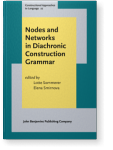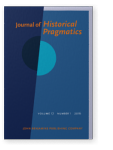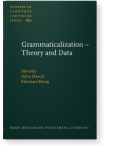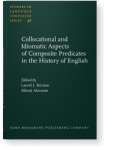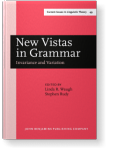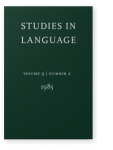Elizabeth Closs Traugott
List of John Benjamins publications for which Elizabeth Closs Traugott plays a role.
Journals
ISSN 1876-1933 | E-ISSN 1876-1941
ISSN 2210-2116 | E-ISSN 2210-2124
Discourse Structuring Markers in English: A historical constructionalist perspective on pragmatics
Elizabeth Closs Traugott
[Constructional Approaches to Language, 33] 2022. xviii, 274 pp.
Subjects Discourse studies | English linguistics | Germanic linguistics | Historical linguistics | Pragmatics | Syntax | Theoretical linguistics
Gradience, Gradualness and Grammaticalization
Edited by Elizabeth Closs Traugott and Graeme Trousdale
[Typological Studies in Language, 90] 2010. ix, 306 pp.
Subjects Historical linguistics | Syntax | Theoretical linguistics
Approaches to Grammaticalization: Volume I. Theoretical and methodological issues
Edited by Elizabeth Closs Traugott and Bernd Heine
[Typological Studies in Language, 19:1] 1991. xii, 360 pp.
Subjects Morphology | Pragmatics | Syntax | Theoretical linguistics | Typology
Approaches to Grammaticalization: Volume II. Types of grammatical markers
Edited by Elizabeth Closs Traugott and Bernd Heine
[Typological Studies in Language, 19:2] 1991. xii, 558 pp.
Subjects Morphology | Pragmatics | Syntax | Theoretical linguistics | Typology
Approaches to Grammaticalization: 2 Volumes (set)
Edited by Elizabeth Closs Traugott and Bernd Heine
[Typological Studies in Language, 19:S] 1990. xii, 360 pp. + xii, 560 pp.
Subjects Morphology | Pragmatics | Syntax | Theoretical linguistics | Typology
Papers from the Fourth International Conference on Historical Linguistics, Stanford, March 26–30 1979
Edited by Elizabeth Closs Traugott, Rebecca Labrum and Susan C. Shepherd
[Current Issues in Linguistic Theory, 14] 1980. x, 437 pp.
Subjects Historical linguistics
2023 Chapter 4. On the rise of a marker of disaffiliation from Others’ discourse Reconnecting Form and Meaning: In honour of Kristin Davidse, Gentens, Caroline, Lobke Ghesquière, William B. McGregor and An Van linden (eds.), pp. 99–122 | Chapter
The discourse marker combination Oh, by the way is typically used to signal “digressive” discourse management and topic-shift from discourse 1 to content in discourse 2. I discuss how the combination came to be conventionalized as a hedge on a potentially face-threatening utterance (OBTW1), as… read more
2021 The rise of a concessive “category reassessment” construction: But fear all the same Historical Pragmatics today: Articles in honour of Andreas H. Jucker, Taavitsainen, Irma and Jonathan Culpeper (eds.), pp. 164–179 | Article
In the Late Modern English period, several expressions arose with concessive ‘despite what might be expected’ meaning, among them anyway, nonetheless and all the same (Lenker 2010). The topic of this paper is the rise of the specialized concessive construction “but (be) X all the same”. In the… read more
2020 Constructional networks and the development of benefactive ditransitives in English Nodes and Networks in Diachronic Construction Grammar, Sommerer, Lotte and Elena Smirnova (eds.), pp. 167–211 | Chapter
In this paper, we address the question of how to model syntactic alternations in Diachronic Construction Grammar terms. We argue that positing horizontal links between constructions in addition to vertical ones is particularly beneficial in accounting for change. Our case study is the emergence of… read more
2020 A study of the development of the Chinese correlative comparative construction from the perspective of constructionalization Diachronica 37:1, pp. 83–126 | Article
The paper addresses the emergence and development of the Chinese correlative comparative construction (CrCC) from the perspective of constructionalization. Most previous historical studies of the CrCC take a grammaticalization approach (e.g., Long 2013), focusing mainly on morphosyntax alone… read more
2019 The development of the Chinese copula shì construction: A diachronic constructional perspective Functions of Language 26:2, pp. 139–176 | Article
This paper investigates the development of the copula shì construction in Chinese from the perspective of diachronic construction grammar (Traugott & Trousdale 2013). In prior work the development has been conceptualized in a grammaticalization framework, with focus on the individual expression… read more
2016 Periphery: Diachronic and cross-linguistic approaches Periphery – Diachronic and Cross-Linguistic Approaches, Higashiizumi, Yuko, Noriko O. Onodera and Sung-Ock S. Sohn (eds.), pp. 163–177 | Article
2016 Do semantic modal maps have a role in a constructionalization approach to modals? Modal Meaning in Construction Grammar, Cappelle, Bert and Ilse Depraetere (eds.), pp. 97–124 | Article
My aim in this paper is to show that, in modified form, semantic connectivity maps of the kind developed in van der Auwera & Plungian (1998) and van der Auwera (2013) can be useful for showing the development over time of relationships among polysemous constructions. Since these maps pertain… read more
2016 On the rise of types of clause-final pragmatic markers in English Journal of Historical Pragmatics 17:1, pp. 26–54 | Article
Much work on pragmatic markers in the history of English has been devoted to expressions used clause-initially at “left periphery”. By contrast, this study provides an account in broad outlines of the incremental development of pragmatic markers in clause-final “right periphery” position.… read more
2015 Toward a coherent account of grammatical constructionalization Diachronic Construction Grammar, Barðdal, Jóhanna, Elena Smirnova, Lotte Sommerer and Spike Gildea (eds.), pp. 51–80 | Article
Diachronic construction grammar addresses a range of theoretical topics from lexicalization to grammaticalization. In most cases, a historical dimension has been added to a largely synchronic theory, or construction grammar has been seen as a tool for diachronic analysis. In the spirit of… read more
2015 The constructionalization of the Chinese cleft construction Studies in Language 39:2, pp. 459–491 | Article
This paper addresses the emergence and development of the Chinese cleft construction, with particular attention to the period from Early Archaic Chinese through Late Medieval Chinese. Prototype copulas are typically of the form [NP SHI NP], are predicational or specificational, and cue information… read more
2014 Intersubjectification and clause periphery Intersubjectivity and Intersubjectification in Grammar and Discourse: Theoretical and descriptive advances, Brems, Lieselotte, Lobke Ghesquière and Freek Van de Velde (eds.), pp. 7–27 | Article
Ways of identifying subjectification and especially intersubjectification are discussed using data from the history of English no doubt and surely. These adverbs arose out of non-modal expressions and were recruited for use as epistemic adverbs and metadiscursive markers. The data are shown not to… read more
2014 Toward a constructional framework for research on language change Cognitive Linguistic Studies 1:1, pp. 3–21 | Article
A construction grammar approach is presented to changes to language as a system that is both communicative and cognitive (Traugott and Trousdale 2013). Constructionalization is defined as the development of formnew-meaningnew pairs and constructional changes as changes to features of constructions.… read more
2014 Toward a constructional framework for research on language change Grammaticalization – Theory and Data, Hancil, Sylvie and Ekkehard König (eds.), pp. 87–106 | Article
Over the past two decades usage-based models of language as a system of form-meaning pairs (‘signs’) have been developed (e.g. Goldberg 1995, 2006; Croft 2001). These models are known as Construction Grammars. Historical approaches using constructionalist frameworks (e.g. Bergs & Diewald 2008;… read more
2014 Contentful constructionalization Journal of Historical Linguistics 4:2, pp. 256–283 | Article
We present a constructionalization framework for thinking about the development of contentful (“lexical”) constructions over time. This framework incorporates and goes beyond earlier work on lexicalization, which largely focuses on reduction in the form of specific lexical items. A… read more
2012 Intersubjectification and clause periphery Intersections of Intersubjectivity, Brems, Lieselotte, Lobke Ghesquière and Freek Van de Velde (eds.), pp. 7–28 | Article
Ways of identifying subjectification and especially intersubjectification are discussed using data from the history of English no doubt and surely. These adverbs arose out of non-modal expressions and were recruited for use as epistemic adverbs and metadiscursive markers. The data are shown not to… read more
2010 Gradience, gradualness and grammaticalization: How do they intersect? Gradience, Gradualness and Grammaticalization, Traugott, Elizabeth Closs and Graeme Trousdale (eds.), pp. 19–44 | Article
This volume is intended to address three questions: (1) How are we to understand the intersection between synchronic gradience and grammaticalization? (2) What insights does grammaticalization offer for assessing the validity of Aarts’s (2007a) claims regarding synchronic gradience, specifically… read more
2010 Preface Gradience, Gradualness and Grammaticalization, Traugott, Elizabeth Closs and Graeme Trousdale (eds.), pp. 1–18 | Preface
2008 Review of Fischer (): Morphosyntactic change: Functional and formal perspectives Functions of Language 15:2, pp. 293–303 | Review
2007 Lexicalization and grammaticalization all over again Historical Linguistics 2005: Selected papers from the 17th International Conference on Historical Linguistics, Madison, Wisconsin, 31 July - 5 August 2005, Salmons, Joseph C. and Shannon Dubenion-Smith (eds.), pp. 3–19 | Article
2007 (Inter)subjectification and unidirectionality Historical Changes in Japanese: Subjectivity and intersubjectivity, Onodera, Noriko O. and Ryoko Suzuki (eds.), pp. 295–309 | Article
In this paper the importance of distinguishing synchronic (inter)subjectivity and diachronic (inter)subjectification is stressed. Questions are posed concerning the robustness of hypotheses about matches between semantic function and syntactic position at the left or right periphery of the clause… read more
2004 A critique of Levinson’s view of Q- and M-inferences in historical pragmatics Journal of Historical Pragmatics 5:1, pp. 1–26 | Article
In Presumptive Meanings: The Theory of Conversational Implicature, Levinson (2000) argues that in historical as well as synchronic work there is need to distinguish three types of pragmatic principles, which he labels the Q-, M-, and I- “heuristics”. This is in contrast to Horn (1984), who argues… read more
2000 Invoking scalarity: The development of in fact Journal of Historical Pragmatics 1:1, pp. 7–25 | Article
The discourse contexts are analyzed in which clause-internal in fact developed pragmaticalized meanings and came to invoke scalarity in two domains: epistemic sentence adverb (IPAdv), and additive discourse marker (DM). In both these uses, in fact tightens word to world fit (Powell 1992): the world… read more
1999 Chapter 8: A Historical Overview of Complex Predicate Types Collocational and Idiomatic Aspects of Composite Predicates in the History of English, Brinton, Laurel J. and Minoji Akimoto (eds.), pp. 239–260 | Chapter
1998 Structural Scope Expansion and Grammaticalization The Limits of Grammaticalization, Giacalone Ramat, Anna and Paul J. Hopper (eds.), pp. 229–272 | Article
1997 Unless and but conditionals: a historical perspective On Conditionals Again, Athanasiadou, Angeliki and René Dirven † (eds.), pp. 145–168 | Article
1997 Review of Labov (1994): Principles of linguistic change, Volume 1: Internal factors Studies in Language 21:1, pp. 228–236 | Review
1995 The Semantic and Pragmatic Development of Substitutive Complex Prepositions in English Historical Pragmatics: Pragmatic developments in the history of English, Jucker, Andreas H. (ed.), pp. 243–274 | Article
1994 Review of Gerritsen & Stein (1992): Internal and external factors in syntactic change Studies in Language 18:2, pp. 489–495 | Review
1991 English speech act verbs: A historical perspective New Vistas in Grammar: Invariance and Variation, Waugh, Linda R. and Stephen Rudy (eds.), pp. 387–406 | Article
1991 Introduction Approaches to Grammaticalization: Volume I. Theoretical and methodological issues, Traugott, Elizabeth Closs and Bernd Heine (eds.), pp. 1–14 | Article
1991 Introduction Approaches to Grammaticalization: Volume II. Types of grammatical markers, Traugott, Elizabeth Closs and Bernd Heine (eds.), pp. 1–14 | Article
1991 The semantics-pragmatics of grammaticalization revisited Approaches to Grammaticalization: Volume I. Theoretical and methodological issues, Traugott, Elizabeth Closs and Bernd Heine (eds.), pp. 189–218 | Article
1990 From less to more situated in language: the unidirectionality of semantic change Papers from the 5th International Conference on English Historical Linguistics, Adamson, Sylvia M., Vivien A. Law, Nigel Vincent and Susan Wright (eds.), pp. 497–518 | Article
1987 On the historical relation between mental and speech act verbs in English and Japanese Papers from the 7th International Conference on Historical Linguistics, Giacalone Ramat, Anna, Onofrio Carruba and Giuliano Bernini (eds.), pp. 561–574 | Article
1986 On the Origins of "AND" and "BUT" Connectives in English Studies in Language 10:1, pp. 137–150 | Article
1985 From Opposition to Iteration: A Study in Semantic Change Studies in Language 9:2, pp. 231–241 | Article
1985 Conditional markers Iconicity in Syntax: Proceedings of a symposium on iconicity in syntax, Stanford, June 24–26, 1983, Haiman, John (ed.), pp. 289–310 | Article
1985 Confrontation and association Papers from the VIth International Conference on Historical Linguistics, Poznań, 22–26 August 1983, Fisiak, Jacek (ed.), pp. 515–526 | Article
1985 “Conventional” and “dead” metaphors revisited The Ubiquity of Metaphor: Metaphor in language and thought, Paprotté, Wolf and René Dirven † (eds.), pp. 17–56 | Article
1982 5. From propositional to textual and expressive meanings; some semantic-pragmatic aspects of
grammaticalization Perspectives on Historical Linguistics: Papers from a conference held at the meeting of the Language Theory Division, Modern Language Assn., San Francisco, 27–30 December 1979, Lehmann, Winfred P. and Yakov Malkiel (eds.), pp. 245–272 | Chapter
1982 Concluding remarks Papers from the Fifth International Conference on Historical Linguistics, Galway, April 6–10 1981, Ahlqvist, Anders (ed.), pp. 460–466 | Miscellaneous
1979 27. Why Black English retains so m any creole Readings in Creole Studies, Hancock, Ian F. (ed.), pp. 339–346 | Chapter













